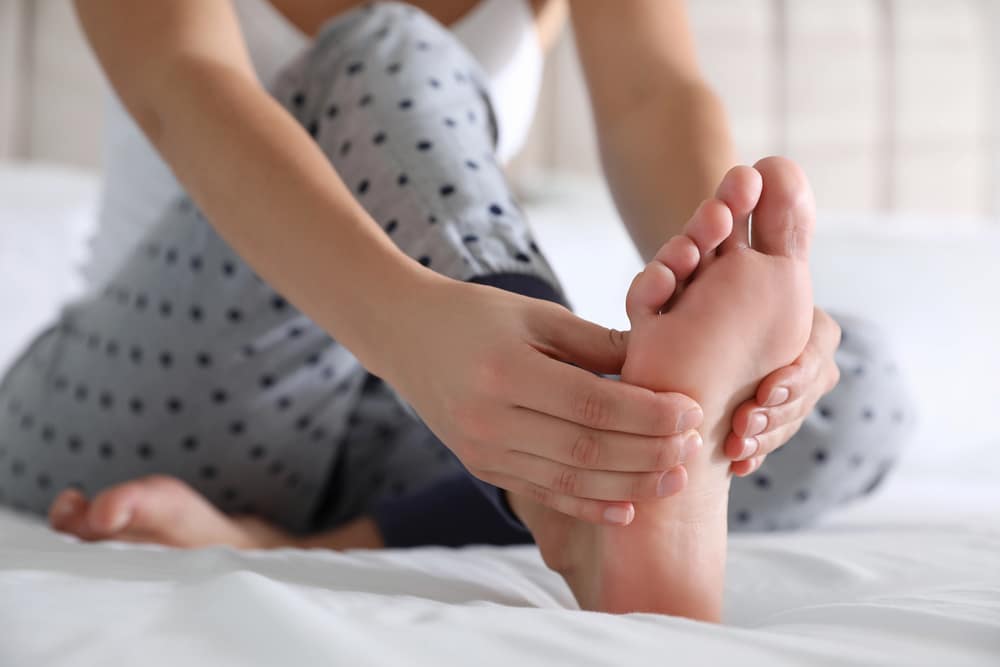
9 Causes Of Nighttime Foot Cramps And How To Manage Them
Foot cramps at night are a common complaint among many adults. One study estimates that up to 60% of adults experience leg or foot cramps at some point in their lives.[1]
Foot cramps at night can catch you off guard, disrupting restful sleep and leaving you uncomfortable for hours. These sudden, involuntary muscle contractions often feel sharp and can affect one or both feet. Many people seek foot cramp relief to help ease these episodes.
Identifying the root cause of these issues is critical to finding lasting relief.
Common Causes of Nighttime Foot Cramps
Dehydration
A primary cause of foot cramps is dehydration.[2] When your body lacks sufficient fluids, it can disrupt the balance of minerals that help regulate muscle contractions. This imbalance may lead to misfiring signals between nerves and muscles, causing sudden cramping.
Staying hydrated throughout the day helps your body transport minerals more effectively and may reduce the chances of foot cramps at night.
Electrolyte Imbalance
Closely tied to dehydration, an imbalance in electrolytes is a frequent trigger for cramps. Potassium, calcium, sodium, and magnesium are key players in muscle contraction and relaxation.[3]
Electrolyte imbalances can result from several factors, including diet, excessive sweating, or certain medications. Whatever the cause, these imbalances may sometimes result in muscles contracting uncontrollably, which is why you may experience foot cramps.
Overexertion or Muscle Fatigue
Excessive physical activity or standing for long periods can tire the muscles in your feet. When muscles become overworked, they are more prone to cramping, especially at night when the body is at rest.
Sometimes new or intense exercise routines may contribute to foot cramps due to muscle strain. Incorporating gentle stretches before bed can ease muscle tension and reduce the frequency of foot cramps.[4]
Poor Circulation
Reduced blood flow to the feet is another potential cause of cramping. Limited circulation, whether from prolonged sitting or other factors, can decrease the supply of oxygen and nutrients to muscle tissue, increasing the chance of spasms. Wearing comfortable footwear and occasionally elevating your feet can help improve circulation.[5]
Age-Related Changes
With age comes numerous physical changes, some of which are related to muscle elasticity. As we age, our muscles can become more susceptible to cramps for several reasons, namely reduced physical activity and change in muscle mass. Regular movement and mild stretching can help keep muscles limber and less prone to nighttime spasms.
Footwear Issues
Uncomfortable footwear could contribute to foot cramps. Ill-fitting shoes or shoes that lack support can strain foot muscles, increasing the risk of cramps. High heels, tight shoes, or worn-out footwear may place undue pressure on muscles and tendons, especially after prolonged use.
Choosing supportive, well-fitting shoes for daily activities may help reduce muscle stress.
Managing Foot Cramps at Night
A few simple adjustments can help reduce the frequency and intensity of nighttime foot cramps:
- Stay Hydrated: Drink water throughout the day to support electrolyte balance and muscle function. Avoid overhydrating right before bed to prevent sleep disruption.
- Eat Mineral-Rich Foods: Include foods high in potassium, calcium, and magnesium (such as bananas, leafy greens, nuts, and dairy) to support proper muscle contraction.[6] If you have questions about your diet, consult a nutritionist or a healthcare professional for advice.
- Stretch Before Bed: Gentle calf stretches, toe flexes, and ankle rotations can relieve tension and improve muscle flexibility. It is always advisable to first consult your doctor or physical therapist.
- Try Gentle Movement: Light walking or low-impact activity during the day may help improve circulation and reduce cramp risk.
- Use Heat or Massage: A heating pad, warm bath, or gentle massage can help relax tight muscles and increase blood flow.
- Apply Cold for Relief: An ice pack may help during a cramp by reducing pain and inflammation. Alternating heat and cold works well for some people.
- Wear Supportive Footwear: Proper shoes can help reduce strain.
- Adjust Sleeping Position: Avoid pointing your toes downward or tucking your feet tightly under blankets. Using a pillow under your knees or calves may help reduce muscle tension.
How Theraworx® Can Help You
If you’re looking for a topical solution for foot cramps, consider Theraworx® for Foot Cramps. When used alongside a proper nutrition, hydration, and exercise routine, and in conjunction with the right footwear, Theraworx® can support your overall journey towards managing and preventing the discomfort you feel when foot cramps strike at night.
Disclaimer: This content is not medical advice and should not replace your doctor’s recommendations.
References:
- Allen, Richard E., and Karl A. Kirby, “Nocturnal Leg Cramps,” American Family Physician 86, no. 4 (2012): 350-355
- U.S. National Library of Medicine. (n.d.). Muscle cramps (Charley horse). MedlinePlus. https://medlineplus.gov/musclecramps.html
- Uçak, B. (2025, July 1). What happens to your body when you drink electrolytes. Verywell Health. https://www.verywellhealth.com/what-are-electrolytes-11764438
- Hallegraeff, J. M., van der Schans, C. P., de Ruiter, R., & Greef, M. H. G. de (2012). Stretching before sleep reduces the frequency and severity of nocturnal leg cramps in older adults: A randomized trial. Journal of Physiotherapy, 58(1), 17–22. https://doi.org/10.1016/S1836-9553(12)70068-1
- Circle Health Group. (2024, March 6). Calf cramping at night: 5 key causes. https://www.circlehealthgroup.co.uk/health-matters/your-body/calf-cramping-at-night
- National Institutes of Health, Office of Dietary Supplements. (2016, February 11). Magnesium: Fact sheet for health professionals. U.S. Department of Health and Human Services. https://ods.od.nih.gov/factsheets/Magnesium-HealthProfessional/